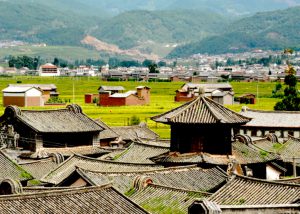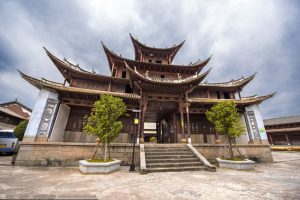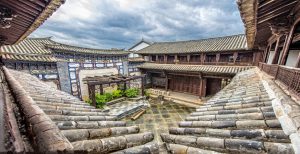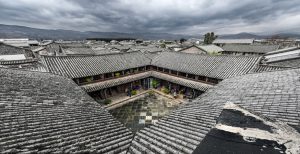Donglianhua Village in Weishan County, Dali

Chinese Name: 东莲花村
Chinese Pinyin: Dong Lian Hua Village
English Name: Donglianhua Village in Weishan County, Dali
Type: ancient village, Muslim Culture
Recommended Visiting Hours: 3-4 hours
Opening Hours: all day
Location: south of Dali, on the way to Weishan Ancient Town
Donglianhua Village is a village of Hui ethnic minority. It is one of the Muslim communities with the most traditional Hui culture in the Weishan County, enjoying the most quaint folk customs, the most colorful folk customs and the richest traditional culture. The whole village offers a flat terrain and convenient transportation. Its foundation can be trace back to early Ming Dynasty. There is also an important bridge built on the Bonan Ancient Road(博南古道) in the Wanli Period of the Ming Dynasty – Yongji Bridge(永济桥), which preserves Zhaozhong Temple in the Qing Dynasty and Du Wenxiu Uprising Site, also the Cultural relics protection units such as the military field, Dadongmen, and the masses.
Why is Donglianhua Village so special?
Donglianhua Village was entitled as the Ecologic Muslim Traditional Culture Protection Area by Yunnan Province in 2017. It is an ancient village of early Ming Dynturrasty. It also enjoys many historical and cultural relics.
Where is Donglianhua Village?
Donglian Village is located in the northeast of Weishan County. It is the center of the dam in Yongjian Town, the first town of source of Honghe River, and the east of Zhangbao Village. It belongs to Yonghe Village Committee.
1.2 km away from Guanwei Highway in the east
25.5 km south of the county in the south
29.5 km north of Xiaguan in the north
How to get to Donglianhua Village?
From Dali, the best way to get to Donglianhua is to take a Weishan-bound bus from the Southwest Bus Station (西南汽车站) in Xiaguan (there is a bus every 10 minutes) to Dacang (大仓). From Weishan, take a green mini-van to Yongjian (永建).
Dacang and Yongjian are pretty much the same location : there are two big villages divided by the new road that links Weishan to Dali. Once in Dacang / Yongjian, try and find a horse-carriage. They are one of the mos popular means of transportation in the region. It should cost 5 yuan.
History

These villages were founded by Muslim soldiers from Central Asia sent to Yunnan by the first emperor of China’s Mongol dynasty of the Yuan(1271-1368). During the Ming and Qing dynasties, they became involved in trade as caravan leaders on the Ancient Tea and Horse Road (茶马古道). The courtyards and mansions of village of Donglianhua (东莲花) shows how successful these Chinese Muslims traders were.
The Muslims of Weishan (巍山) region in Yunnan (as well as other Chinese regions) belong to the Hui ethnic group (回族). The ancestry of the Hui varies. Some are the descendants of intermarriages between Muslim men of Middle-eastern or Central Asian origins and local women, others are the descendants of Han-Chinese who converted to Islam.
Dispatched by the Mongolian
During the 12th and 13th centuries, the Mongolians conquered most of Asia and parts of Eastern Europe. In China, they founded the short-lived Yuan dynasty (1271-1368) and anchored Yunnan into the Chinese empire, a thing that previous dynasties had not succeeded.
The first emperor of the Yuan dynasty appointed a man from Bukhara in Uzbekistan, Sayyed Ajjal Shams al-Din Omar (赛典赤·赡思丁), to become the governor of Yunann province. Sayyed Omar sent some of his armies from his homeland to the Weishan region where they founded three villages: Daweigeng (大围埂), Xiaoweigeng (小围埂) and Huihuideng (回辉登). They were advanced military outposts on the borderland.
Merging process during the Ming
These Central Asian Muslim soldiers, as they settled in the region, married local Yi women who converted to Islam. The community’s population grew and other villages were founded around the nucleus of Daweigeng, Xiaoweigeng and Huihuandeng. A descendant of Sayyed Ajjal Shams al-Din Oma founded the village of Donglianhua.

Under the Yuan dynasty, foreign religion prospered. However, after the Ming dynasty overthrew the Yuan, Islam was tolerated, but Muslim men were encouraged to intermarry with Han women and to integrate with Chinese society.
Built at the beginning of the Qing dynasty, the mosque of Donglianhua shows that from an architectural point of view Islam in China had gone through a process of sinicization. The minaret and the prayer hall have adopted Chinese architectural style of the time.
The crescent and star that top the mosque gate and the Chinese characters for mosque (清真寺 – Temple of the Pure Truth) are the only indicators that this building is actually a mosque.
Ancient Tea and Horse Road
Hui men became part of the Tea and Horse Road as caravan leaders. They were part of this multi-ethnic trade that linked Dai and Hani tea producers in Xishuangbanna (西双版纳), Han Chinese merchants and tea processors in Pu’er, Hui Muslim muleteers, and Tibetan people who were the end-users.
Hui muleteers lead up to 100 horses and transported tea, silks, sugar and other products on the Tea and Horse Road (茶马古道) with an average of 30 miles a day.
The Panthay rebellion led by Du Wenxiu (杜文秀) started just a few kilometers from Donglianghua, in Xiaoweigeng. This anti-Qing dynasty rebellion that shook Yunnan between 1856 and 1873 interrupted the Tea and Horse Road (茶马古道), but the Tibetan’s people craving for Pu’er tea was too strong.
Between the end of the Panthay rebellion and the beginning of WWII, some Hui caravan leaders and merchants had built up strong trade connections in Yunnan, Burma and India, and had also managed to amass an impressive wealth. In Donglianhua, the three Ma brothers, Ma Ruyi (马如骥), Ma Ruqi (马如骐) and Ma Ruqing (马如清) of Donglianhua are the embodiment of this success.
Courtyards and Mansions

The three most important are the Ma Ruji courtyard (马如骥大院) the Ma Ruqi courtyard (马如骐大院) and the Ma Ruqing courtyard (马如清大院). They were all built between the beginning of the 20th century when the Qing dynasty was on the verge to collapse and the Republican Era. Unfortunately, with the war creeping in and military official of the Guomindang (国民党)
Coincidentally, the most common Hui family name in the region is Ma (马), which also means ‘horse’ in Chinese and the name of these means is irremediably link to the horse. The first two names of this Ma clan Hui merchant, Ruji and Ruqi, means respectively ‘as[ 如] a fine horse [骥]’ and ‘as[ 如] a black stallion 骐’, while the last one means ‘as [如] purity [清]’.
One courtyard have been transformed into museums. Collectively own by the community of Donglianhua, it is open to the public. One other courtyard is a private residence and the last one also function as a restaurant.
Cultural and Historical Significance
- Ethnic Bai Heritage: Donglianhua Village is predominantly inhabited by the Bai ethnic group, known for their distinctive culture and architecture.
- Traditional Architecture: The village is renowned for its well-preserved Bai-style architecture, characterized by white walls, grey tile roofs, and intricately carved wooden doors and windows.
- Cultural Practices: Visitors can experience traditional Bai customs, such as local festivals, music, dance, and handicrafts.
What to See
The Donglianhua Village, lying in a green field, is surrounded by several green tiles, with different shapes and slightly vicissitudes. It is connected to the mosque and old courtyard with beautiful decoration and historical vicissitudes. The preserved Muslim ancient house has become an ancient village with a strong Muslim style and a harmonious blend of traditional Muslim culture and various ethnic cultures.
Because of the low terrain, abundant water and fertile land, it is suitable for planting lotus. The villagers often live on planting Lotus seedlings. There are lotus flower dotted with villages, hence the name Donglianhua Village.
Architecture Feature

There are 28 ancient dwellings in the village. The main buildings has an area of 5.5 hectares, of which Qing building covering an area of 10,064 square meters and the building of Republic of China covering 17,966 square meters. It is also the main core protection area of the village. The village enjoys the grand mosques, turrets and courtyards, deep courtyard, interconnected houses and yards, forming the perfect combination of earth and stone. The layout is unique in terms of lighting, heat insulation, drainage and defense. These architecture echo each other. Doors, windows, houses, wall and roofs are carved with dragons and dragons. They enjoys favorable wood carving, screen and exquisite stone carving in the yard. Each corner of the building shows different artistic charms. It embodies the harmonious integration of traditional Islamic culture with other national cultures.
Attractions and Activities
- Donglianhua Mosque: One of the highlights of Donglianhua Village is its mosque, which reflects the Muslim cultural presence in the region. The mosque is an architectural gem with historical significance, attracting visitors interested in cultural and religious heritage.
- Local Markets: Explore village markets where you can find traditional Bai handicrafts, local produce, and snacks.
- Scenic Walks: Enjoy leisurely walks through the village, admiring the peaceful surroundings and interacting with friendly locals.
- Photography Opportunities: Capture picturesque scenes of Bai architecture against the backdrop of rural landscapes.
Practical Tips for Visitors
- Getting There: From Dali City, you can reach Weishan County by bus or private transport. From Weishan County, local transportation options like taxis or hired vehicles can take you to Donglianhua Village.
- Accommodation: While Donglianhua Village itself may not have large hotels, nearby Weishan County offers a range of accommodations to suit different budgets and preferences.
- Respect Local Customs: When visiting the mosque or interacting with villagers, it’s important to dress modestly and respect local customs and traditions.
- Timing: Plan your visit to Donglianhua Village during daylight hours to fully appreciate its beauty and cultural offerings.
Recommended Tours
1 Day Weishan Snack Festival Tour
9 Days Yunnan Classic Tour with Muslim Culture Exploration
13 Days Yunnan Muslim Culture Discovery Tour
Nearby Attraction
Weishan Ancient Town is located at the foot of Ailao Mountain. It is a historical and cultural city known as the cradle of Nanzhao Kingdom. First built in Yuan Dynasty, Weishan Ancient Town has been changed to the brick city and remained the style and features until today. As the place that carry out Tusi System for the longest time in Yunnan, the long history of Weishan breeds numerous temples, echoing with the natural landscape at the diatance.
Weibao Mountain (巍宝山), also known as Weishan Mountain, is one of the birthplaces of the Nanzhao. In the past, he local Yi people held a temple fair in Weibao Mountain, which is the ancestral holy land of the Yi people. Today, Weibao Mountain enjoys the flourishing vegetation, towering trees and booming flowers. It is one of the famous Taoist mountains of China.
Useful Travel Tips
When the weather is fine in Dali, the sunshine is heated, and ultraviolet light is strong. People should avoid direct sunlight, and the sun hat preparation is required during outdoor activities, a pair of sunglasses will make you comfortable in the trip.
Respect local custom and local culture.

 7 Days GolfingTour
7 Days GolfingTour
 8 Days Group Tour
8 Days Group Tour
 8 Days Yunnan Tour
8 Days Yunnan Tour
 7 Days Shangri La Hiking
7 Days Shangri La Hiking
 11 Days Yunnan Tour
11 Days Yunnan Tour
 6 Days Yuanyang Terraces
6 Days Yuanyang Terraces
 11 Days Yunnan Tour
11 Days Yunnan Tour
 8 Days South Yunnan
8 Days South Yunnan
 7 Days Tea Tour
7 Days Tea Tour
 8 Days Muslim Tour
8 Days Muslim Tour
 12 Days Self-Driving
12 Days Self-Driving
 4 Days Haba Climbing
4 Days Haba Climbing
 Tiger Leaping Gorge
Tiger Leaping Gorge
 Stone Forest
Stone Forest
 Yunnan-Tibet
Yunnan-Tibet
 Hani Rice Terraces
Hani Rice Terraces
 Kunming
Kunming
 Lijiang
Lijiang
 Shangri-la
Shangri-la
 Dali
Dali
 XishuangBanna
XishuangBanna
 Honghe
Honghe
 Kunming
Kunming
 Lijiang
Lijiang
 Shangri-la
Shangri-la
 Yuanyang Rice Terraces
Yuanyang Rice Terraces
 Nujiang
Nujiang
 XishuangBanna
XishuangBanna
 Spring City Golf
Spring City Golf
 Snow Mountain Golf
Snow Mountain Golf
 Stone Mountain Golf
Stone Mountain Golf
















